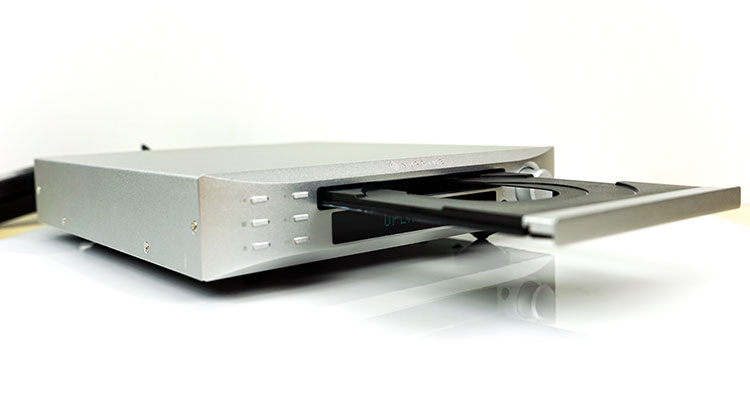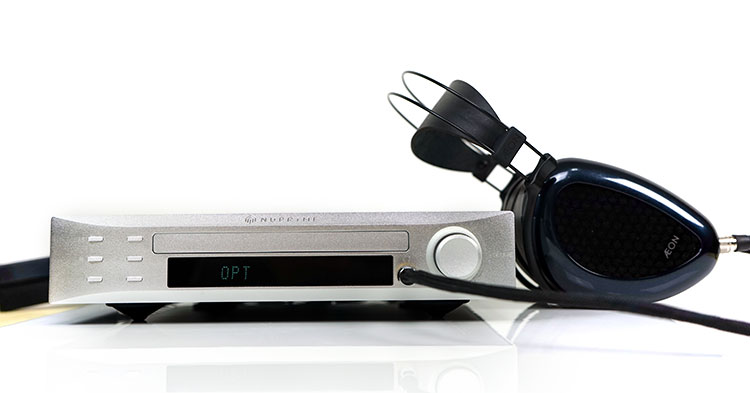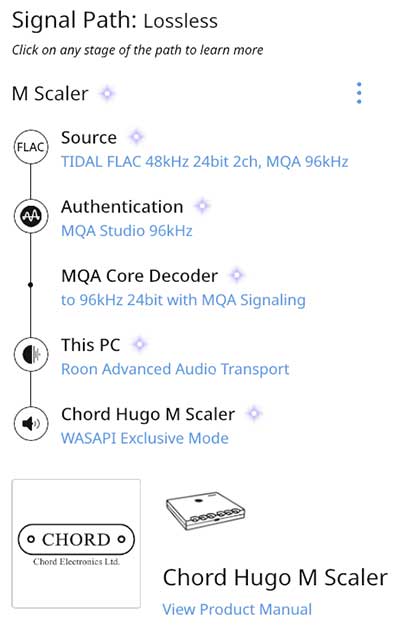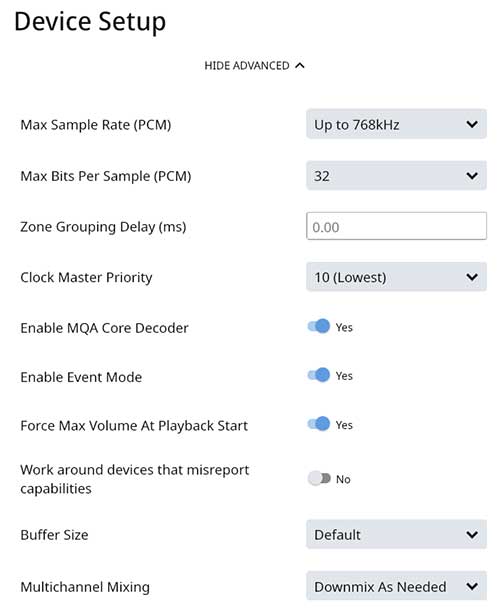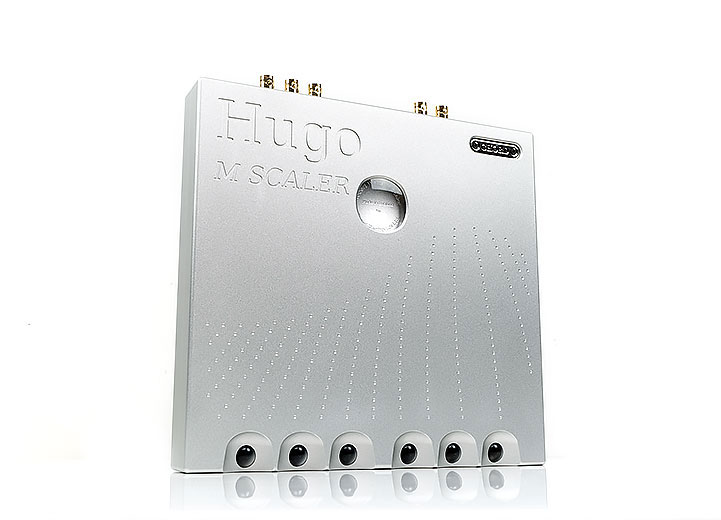Select Comparisons
NuPrime CDP9
€1695.00
Technical
The CD9 is more of a high-end Swiss army knife for audio duties than a dedicated upsampler like the Hugo M Scalers. It is a DAC, CD player as well as an upsampler but it does come at a much lower price of just under $2000.
Like the Chord M Scaler, the CD9 has a switchable upsampling capability with a number of preset levels that can lift a signal from a wide range of sources. That includes CD playback, optical, coaxial, and USB but not BNC. Sampling rates are as wide as the M Scaler ranging between PCM and DSD, from 44.1kHz to 768kHz or DSD64 to DSD512.
Because it is also a DAC the CDP9 also offers analog outputs both balanced and unbalanced and even a small 3.5mm TRS output stage for headphones and earphones. The M Scaler requires a secondary DAC component to complete the signal chain preferably one with dual-BNC input.
Unlike the Chord M-Scaler, the CDP9 uses an off-the-shelf delta-sigma ES9028PRO DAC chipset with a switchable power supply. The demands for upsampling are also via FPGA like the M Scaler but this is also mixed in with power requirements for second-stage decoding into an analog signal as well as reading CDs. T
he M Scaler has no such power demands other than its FPGA-driven upsampling so noise is less of a factor.
Performance
The setup for this comparison is as follows. 44.1K/16BIT into Foobar2000, Windows 10 with WASAPI for the Nuprime CDP9 and ASIO 1.05 for Chord.
From the PC it is USB to both DACs then dual-BNC to the Qutest from the M Scaler and dual RCA to Hifiman’s Jade amplifier. From the NuPrime it is also dual analog to the Hifiman Jade amplifier. Headphones used include the Stax Sr007 MKII and the Abyss Diana Phi.
Stock Sound
First is the stock sound. The M-Scaler/Qutest pairing is much more dynamic sounding, with a fuller and slightly warmer instrumental timbre and a more holographic soundstage.
You hear it most on the low-end where the Chord setup sounds deeper but also has a tiny bit more bloom and less mid-bass punch. The CDP9 sounds cleaner and punchier but a little drier on notes beyond.
The CDP9 has been tuned to be a little more expressive and energetic from the mids upwards. Treble has a stronger presence, more typical of classic Sabre DAC clear but slightly hard-edged signatures and not as wet as the Qutest.
The Qutest is lively up top, more so than the Hugo 2, but not as glassy or dry in its overtones as the CDP9. You get less of that odd-harmonic filtering down into the timbre with the Qutest. Combine that with slightly more bass bloom and more depth and you get a smoother full-bodied natural sound.
Upsampling
This is a strange bit for me with the CDP9 upsampling as compared to its stock sound. I am not entirely sure the PCM44.1k base rate is purely a bypass filter on the CDP9 like the red 44.1k rate on the M Scaler. The reason for that is the subtle tuning changes when I switch between non-sampled and sampled 44.1k on the CDP9.
First, I do detect a very slight diminution of dynamic range but this could also be a dB setting because it is a lot lower on the DSD sampling alternative on the CDP9. The second is the low-end of the 44.1K sounds slightly diminished and more linear in its tuning compared to when sampling is turned off.
Now, to me, the upsampling on the CDP9 from there up to 768kHz sounds like it is increasing the resolution on that 44.1k tuning and not the stock sound. That means it stays relatively linear but like the M Scaler, you definitely do get an enhanced level of perceived detail in the mids upwards.
Staging expands out a little above your head and there is what I call a bit more “fill” in terms of imaging in the upper mids and treble.
Differences
That is not too far from what the M Scaler does but there are a few differences. The first is the level of perceived digitization in the upsampled sound quality.
Beyond the 96k sampling rate, the CDP9 starts to sound slightly artificial to my ear compared to the M Scaler upsampling. 96k is the perfect level for the CDP9 in terms of balancing enhanced perceived resolution and a natural sound to its core signature.
The second difference is how the Chord Hugo M Scaler/Qutest pairing keeps everything sounding natural regardless of the rate. You do get a more reference sound but it’s more beneficial than artificial.
The M Scaler shapes reduce the bass bloom and enhance the vividness of the upper mids and treble clarity. It does not sound digital at all. It sounds, even more, real than its 44.1K relaxed presentation so I tend to keep it on 768K sampling for everything.
You could argue the third difference is the additional DSD upsampling on the CDP9 which the M Scaler does not have. I can see why, and I alluded to that in my original CDP9 review. It is too soft, dB takes a hit and vocals are not to the fore. PCM on the CDP9 is better but both are not as natural and vivid as the M Scaler treatment.
Sofware-Based Upsampling
Roon
$119 a year or $499 one-time life payment
The arguments
Roon has often argued that techniques such as upsampling are better applied closer to the source file in the system setup and that a PC has a more powerful CPU than many DACs out there for FPGA computations.
For many commercial DAC that may well be true. However, whilst the M Scaler still may have to receive a signal from the PC it can argue that it is about as close as it can get without jumping into the PC. Second, the source does not even need to be a PC and here PC CPU power becomes moot if it is a regular CD Player, for example.
Finally, the M Scaler’s dedicated FPGA setup and processor will likely be a lot more isolated for jitter and noise than PCs unless you switch Roon’s Clock Master priority setting to 1 and they may lead to instability on your PC if you are heavily multitasking.
I actually tried Clock Level 1 and for the most part, it was fine on a hefty AMD Ryzen 20GB RAM setup. However, the odd time I get some disruption that I didn’t get at the default, (setting).
Technical
Roon comes loaded with some pretty extensive sampling and filtering techniques in its DSP engine. Quite apart from sampling from 44.1k up to 768k, you can also adapt your filtering technique from linear to minimum phases depending on your preferences.
The Chord Hugo M Scaler does not use filtering typical of what you find within GUI-based OS layering for delta-sigma DAC implementations. Neither does it possess the ability to choose the max level of bit sampling alongside the sample rate such as 16BIT to 32BIT.
Having said that I tend to set that anyway inside Foobar2000 when transmitting via ASIO to the M Scaler so it is already there in my non-Roon media setup.
Performance
The treatment of the sample with the Chord Hugo M Scaler set to bypass and upsampled via Roon only actually follows a similar pattern as the M Scaler’s upsampling in terms of improvements in the technical domain.
However, the qualitative gap between the 44.1k sample rate and the 768k does not seem quite as substantial as the M Scaler. I can indeed pick up a slightly better vocal performance and the generally more vivid midrange/treble via Roon but it is not as dramatic. Instrumental separation does improve. The decay on 768k Roon upsampling seems slightly shorter which helps with the bass layering for me on some of my punchy synth-wave tracks.
The M Scaler, by comparison, has upsampling adjustments at 768k that are so much easier to pick out with the setup used. Bypassing sounds lifeless at this point with far greater detail and dynamism at the max rate.
Roon does a good job with injecting a more instrumental separation and air but the technical change-up is not so immediate and lacks the same “vivid” factor of the M Scaler’s similar rate.
Our Verdict
The Chord Hugo M Scaler is possibly one of the most intriguing journeys I have had in a long time when writing a review. I will also say it’s possibly one of the most difficult write-ups I have had to do. Not because it was bad, quite the opposite, it is rather brilliant.
It is more about how to describe that brilliance in easily understood words to the headphone and portable audio crowds because the changes are like nothing I have experienced before in this hobby.
The concept of a ‘lens’ on your music is apt, the idea that dynamic range and how ‘vivid’ your best setup can sound can be improved is relevant. However, you need a revealing setup to get the benefits.
Is it the final step or the fabled ‘end game’? No, because the M Scaler is but one piece in a long chain. Improve other aspects of that chain and it is likely the M Scaler will happily shuffle up another level to match that improvement. I would argue it helps everything else get a little closer to being an ‘end game’.
Going modular does retain the shelf life of the M Scaler immeasurably. Not only is my ‘humble’ Qutest DAC transformed but it leaves me wondering what if I had an even better Chord DAC or connected it to a more expansive HiFi speaker system? Something perhaps where the results are more readily detected and shared?
Well, that’s just GAS now, isn’t it? The M Scaler may well be world-class, but my wallet is definitely 3rd rate. Bah humbug!
Chord Hugo M Scaler Specifications
- PGA: Xilinx XC7A200T
- Filter tap length: 1,015,808 WTA taps
- Dimensions: 235 x 40.5 x 236mm (WxHxD)
- Weight: 2.55kg





